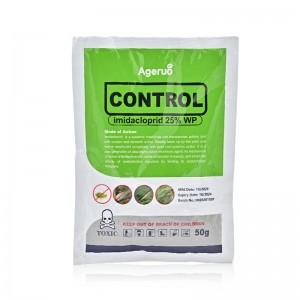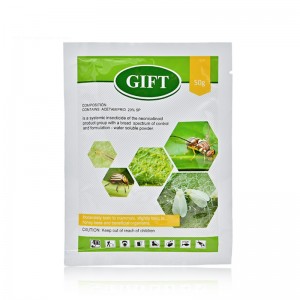In modern agriculture, the choice of insecticides is crucial for improving crop yield and quality. Imidacloprid and acetamiprid are two commonly used insecticides that are widely used to control various pests. In this paper, we will discuss the differences between these two insecticides in detail, including their chemical structure, mechanism of action, application range, and advantages and disadvantages.
What is Imidacloprid?
Imidacloprid is a widely used neonicotinoid insecticide that controls farmland pests by interfering with nerve conduction in insects. Imidacloprid binds to receptors that cause hyperexcitability of the insect’s nervous system, ultimately leading to paralysis and death.
| Active ingredients | Imidacloprid |
| CAS Number | 138261-41-3;105827-78-9 |
| Molecular Formula | C9H10ClN5O2 |
| Application | Control such as aphids, planthoppers, whiteflies, leafhoppers, thrips; It is also effective against some pests of Coleoptera, Diptera and Lepidoptera, such as rice weevil, rice borer, leaf miner, etc. It can be used for rice, wheat, corn, cotton, potatoes, vegetables, beets, fruit trees and other crops. |
| Brand Name | Ageruo |
| Shelf life | 2 Years |
| Purity | 25% WP |
| State | Power |
| Label | Customized |
| Formulations | 70% WS, 10% WP, 25% WP, 12.5% SL,2.5%WP |
| The mixed formulation product | 1.Imidacloprid 0.1%+ Monosultap 0.9% GR 2.Imidacloprid 25%+Bifenthrin 5% DF 3.Imidacloprid 18%+Difenoconazole 1% FS 4.Imidacloprid 5%+Chlorpyrifos 20% CS 5.Imidacloprid 1%+Cypermethrin 4% EC |
Related reading: Emamectin Benzoate vs. Imidacloprid
Process of action
Binding to receptors: Imidacloprid enters the insect’s body and binds to nicotinic acetylcholine receptors in the central nervous system.
Blocking conduction: After the receptor is activated, nerve conduction is blocked.
Neurological disruption: The insect’s nervous system becomes over-excited and is unable to transmit signals properly.
Insect death: Continued nerve disruption leads to paralysis and eventual death of the insect.
Application areas of Imidacloprid
Imidacloprid is widely used in many fields such as agriculture, horticulture, forestry, etc. It is mainly used to control stinging mouthparts pests, such as aphids, leafhoppers and whiteflies.
Crop protection
Grain crops: rice, wheat, corn, etc.
Cash crops: cotton, soybean, sugar beet, etc.
Fruit and vegetable crops: apple, citrus, grape, tomato, cucumber, etc.
Horticulture and Forestry
Ornamental plants: flowers, trees, shrubs, etc.
Forestry protection: control of pine caterpillars, pine caterpillars and other pests
Household & Pets
Household pest control: control of ants, cockroaches and other household pests
Pet care: for the control of external parasites of pets, such as fleas, ticks, etc.
Using Method
| Formulations | Crop names | Targeted Pests | Dosage | Usage method |
| 25% WP | Wheat | Aphid | 180-240 g/ha | Spray |
| Rice | Ricehoppers | 90-120 g/ha | Spray | |
| 600g/L FS | Wheat | Aphid | 400-600g/100kg seeds | Seed coating |
| Peanut | Grub | 300-400ml/100kg seeds | Seed coating | |
| Corn | Golden Needle Worm | 400-600ml/100kg seeds | Seed coating | |
| Corn | Grub | 400-600ml/100kg seeds | Seed coating | |
| 70% WDG | Cabbage | Aphid | 150-200g/ha | spray |
| Cotton | Aphid | 200-400g/ha | spray | |
| Wheat | Aphid | 200-400g/ha | spray | |
| 2% GR | lawn | Grub | 100-200kg/ha | spread |
| Chives | Leek Maggot | 100-150kg/ha | spread | |
| Cucumber | Whitefly | 300-400kg/ha | spread | |
| 0.1% GR | Sugar cane | Aphid | 4000-5000kg/ha | ditch |
| Peanut | Grub | 4000-5000kg/ha | spread | |
| Wheat | Aphid | 4000-5000kg/ha | spread |
What is Acetamiprid?
Acetamiprid is a new type of chlorinated nicotine insecticide, which is widely used in agriculture for its excellent insecticidal effect and low toxicity. Acetamiprid interferes with the insect’s nervous system, blocking nerve transmission and causing paralysis and death.
| Active ingredients | Acetamiprid |
| CAS Number | 135410-20-7 |
| Molecular Formula | C10H11ClN4 |
| Classification | Insecticide |
| Brand Name | POMAIS |
| Shelf life | 2 Years |
| Purity | 20% SP |
| State | Powder |
| Label | Customized |
| Formulations | 20%SP; 20%WP |
| The mixed formulation product | 1.Acetamiprid 15%+Flonicamid 20% WDG 2.Acetamiprid 3.5% +Lambda-cyhalothrin 1.5% ME 3.Acetamiprid 1.5%+Abamectin 0.3% ME 4.Acetamiprid 20%+Lambda-cyhalothrin 5% EC 5.Acetamiprid 22.7%+Bifenthrin 27.3% WP |
Process of action
Binding receptor: After entering the insect, acetamiprid binds to the nicotinic acetylcholine receptor in the central nervous system.
Blocking conduction: After the receptor is activated, nerve conduction is blocked.
Neurological disruption: The insect’s nervous system becomes over-excited and is unable to transmit signals properly.
Insect death: Continued nerve disorders lead to paralysis and eventual death of the insect.
Application areas of acetamiprid
Acetamiprid is widely used in many fields such as agriculture and horticulture, mainly for controlling stinging mouthparts pests such as aphids and whiteflies.
Crop protection
Grain crops: rice, wheat, corn, etc.
Cash crops: cotton, soybean, sugar beet, etc.
Fruit and vegetable crops: apple, citrus, grape, tomato, cucumber, etc.
Horticulture
Ornamental plants: flowers, trees, shrubs, etc.
How To Use Acetamiprid
| Formulations | Crop names | Fungal diseases | Dosage | Usage method |
| 5% ME | Cabbage | Aphid | 2000-4000ml/ha | spray |
| Cucumber | Aphid | 1800-3000ml/ha | spray | |
| Cotton | Aphid | 2000-3000ml/ha | spray | |
| 70% WDG | Cucumber | Aphid | 200-250 g/ha | spray |
| Cotton | Aphid | 104.7-142 g/ha | spray | |
| 20% SL | Cotton | Aphid | 800-1000/ha | spray |
| Tea tree | Tea green leafhopper | 500~750ml/ha | spray | |
| Cucumber | Aphid | 600-800g/ha | spray | |
| 5% EC | Cotton | Aphid | 3000-4000ml/ha | spray |
| Radish | Article yellow jump armour | 6000-12000ml/ha | spray | |
| Celery | Aphid | 2400-3600ml/ha | spray | |
| 70% WP | Cucumber | Aphid | 200-300g/ha | spray |
| Wheat | Aphid | 270-330 g/ha | spray |
Differences between imidacloprid and acetamiprid
Different chemical structures
Imidacloprid and acetamiprid both belong to neonicotinoid insecticides, but their chemical structures are different. The molecular formula of Imidacloprid is C9H10ClN5O2, while that of Acetamiprid is C10H11ClN4. Although they both contain chlorine, Imidacloprid contains an oxygen atom, while Acetamiprid contains a cyano group.
Difference in mechanism of action
Imidacloprid works by interfering with nerve conduction in insects. It binds to nicotinic acetylcholine receptors in the insect’s central nervous system, blocking neurotransmission and causing paralysis and death.
Acetamiprid also acts by acting on the nicotinic acetylcholine receptor in insects, but its binding site is different from that of imidacloprid. Acetamiprid has a lower affinity for the receptor, so higher doses may be needed to achieve the same effect in some insects.
Differences in application areas
Application of Imidacloprid
Imidacloprid is effective against stinging mouthparts pests such as aphids, leafhoppers and whiteflies. Imidacloprid is widely used in a variety of crops including:
Rice
Wheat
Cotton
Vegetables
Fruits
Application of acetamiprid
Acetamiprid has good control effect on many kinds of Homoptera and Hemiptera pests, especially aphids and whiteflies. Acetamiprid is mainly used:
Vegetables
Fruits
Tea
Flowers
Comparison of advantages and disadvantages
Advantages of Imidacloprid
High efficiency and low toxicity, effective against a wide range of pests
Long duration of efficacy, reducing the frequency of spraying
Relatively safe for crops and the environment
Disadvantages of Imidacloprid
Easy to accumulate in the soil and may cause contamination of groundwater
Resistance to some pests has emerged
Advantages of acetamiprid
Lower toxicity, safer for humans and animals
Effective against resistant pests
Rapid degradation, low residue risk
Disadvantages of acetamiprid
Slower effect on some pests, requiring higher dosages
Shorter duration of efficacy, need to be applied more frequently
Recommendations for use
Choosing the right insecticide for specific agricultural needs and pest species is key. Imidacloprid is suitable for stubborn pests and long term protection, while acetamiprid is suitable for environments requiring low toxicity and rapid degradation.
Integrated management strategies
To maximize the effectiveness of insecticides, integrated pest management (IPM) strategies are recommended, which include rotating different types of insecticides and combining biological and physical control methods to reduce pest resistance and improve the sustainability of agricultural production.
Conclusion
Imidacloprid and acetamiprid as neonicotinoid insecticides play an important role in agricultural production. Understanding their differences and application range helps farmers and agricultural technicians to better select and use these insecticides to ensure healthy growth and high yield of crops. Through scientific and rational use, we can effectively control pests, protect the environment and realize the sustainable development of agriculture.
Post time: Jun-21-2024









